Resumen
A PointGeometry is a shape that has neither length nor area at a given scale.
Debate
En muchos flujos de trabajo de geoprocesamiento, puede que necesite ejecutar una operación concreta utilizando información de coordenadas y geometría, pero que no necesariamente desee pasar por el proceso de crear una nueva clase de entidad (temporal), llenar la clase de entidad con cursores, utilizar la clase de entidad y, a continuación, eliminar la clase de entidad temporal. En su lugar, puede utilizar objetos de geometría tanto para la entrada como para la salida con el fin de facilitar el geoprocesamiento. Los objetos de geometría se pueden crear desde cero usando clases Geometry, Multipoint, PointGeometry, Polygon o Polyline.
Sintaxis
PointGeometry (inputs, {spatial_reference}, {has_z}, {has_m})| Parámetro | Explicación | Tipo de datos |
inputs | The Point used to create the object. | Point |
spatial_reference | The spatial reference of the new geometry. (El valor predeterminado es None) | SpatialReference |
has_z | The Z state: True for geometry if Z is enabled and False if it is not. (El valor predeterminado es False) | Boolean |
has_m | The M state: True for geometry if M is enabled and False if it is not. (El valor predeterminado es False) | Boolean |
Propiedades
| Propiedad | Explicación | Tipo de datos |
| JSON (Sólo lectura) | Returns an Esri JSON representation of the geometry as a string. | String |
| WKB (Sólo lectura) | Returns the well-known binary (WKB) representation for OGC geometry. It provides a portable representation of a geometry value as a contiguous stream of bytes. | Bytearray |
| WKT (Sólo lectura) | Returns the well-known text (WKT) representation for OGC geometry. It provides a portable representation of a geometry value as a text string. Any true curves in the geometry will be densified into approximate curves in the WKT string. | String |
| area (Sólo lectura) | The area of a polygon feature. Empty for all other feature types. | Double |
| centroid (Sólo lectura) | The true centroid if it is within or on the feature; otherwise, the label point is returned. Returns a point object. | Point |
| extent (Lectura y escritura) | The extent of the geometry. | Extent |
| firstPoint (Sólo lectura) | The first coordinate point of the geometry. | Point |
| hullRectangle (Sólo lectura) | A space-delimited string of the coordinate pairs of the convex hull rectangle. | String |
| isMultipart (Sólo lectura) | True, if the number of parts for this geometry is more than one. | Boolean |
| labelPoint (Sólo lectura) | The point at which the label is located. The labelPoint is always located within or on a feature. | Point |
| lastPoint (Sólo lectura) | The last coordinate of the feature. | Point |
| length (Sólo lectura) | The length of the linear feature. Zero for point and multipoint feature types. | Double |
| length3D (Lectura y escritura) | The 3D length of the linear feature. Zero for point and multipoint feature types. | Double |
| partCount (Sólo lectura) | The number of geometry parts for the feature. | Integer |
| pointCount (Sólo lectura) | The total number of points for the feature. | Integer |
| spatialReference (Sólo lectura) | The spatial reference of the geometry. | SpatialReference |
| trueCentroid (Sólo lectura) | The center of gravity for a feature. | Point |
| type (Sólo lectura) | The geometry type: polygon, polyline, point, multipoint, multipatch, dimension, or annotation. | String |
Vista general del método
| Método | Explicación |
| angleAndDistanceTo (other, {method}) | Returns a tuple of angle and distance to another point using a measurement type. |
| boundary () | Constructs the boundary of the geometry. 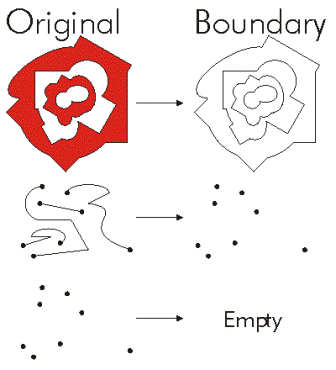 |
| buffer (distance) | Constructs a polygon at a specified distance from the geometry. 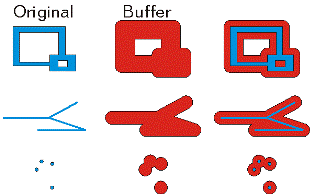 |
| clip (envelope) | Constructs the intersection of the geometry and the specified extent. 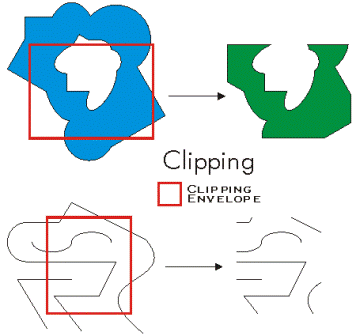 |
| contains (second_geometry, {relation}) | Indicates if the base geometry contains the comparison geometry. contains is the opposite of within. Only True relationships are shown in this illustration. 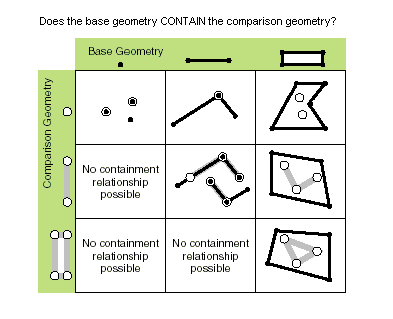 |
| convexHull () | Constructs the geometry that is the minimal bounding polygon such that all outer angles are convex. 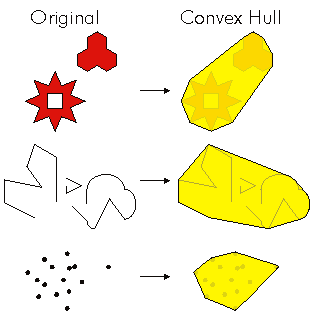 |
| crosses (second_geometry) | Indicates if the two geometries intersect in a geometry of a lesser shape type. Two polylines cross if they share only points in common, at least one of which is not an endpoint. A polyline and an polygon cross if they share a polyline or a point (for vertical line) in common on the interior of the polygon which is not equivalent to the entire polyline. Only True relationships are shown in this illustration. 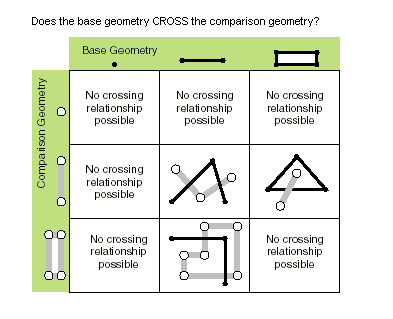 |
| cut (cutter) | Splits this geometry into a part left of the cutting polyline, and a part right of it. When a polyline or polygon is cut, it is split where it intersects the cutter polyline. Each piece is classified as left of or right of the cutter. This classification is based on the orientation of the cutter line. Parts of the target polyline that do not intersect the cutting polyline are returned as part of the right of result for that input polyline. If a geometry is not cut, the left geometry will be empty (None). 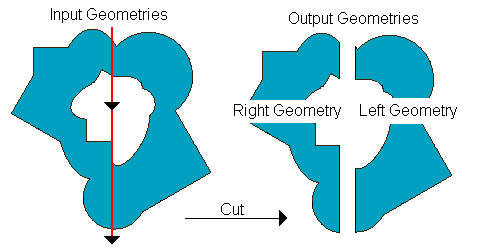 |
| densify (type, distance, deviation) | Creates a new geometry with added vertices. |
| difference (other) | Constructs the geometry that is composed only of the region unique to the base geometry but not part of the other geometry. The following illustration shows the results when the red polygon is the source geometry. 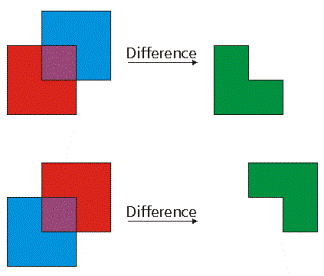 |
| disjoint (second_geometry) | Indicates if the base and comparison geometries share no points in common. Two geometries intersect if disjoint returns False. Only True relationships are shown in this illustration.  |
| distanceTo (other) | Returns the minimum distance between two geometries. If the geometries intersect, the minimum distance is 0. Both geometries must have the same projection. |
| equals (second_geometry) | Indicates if the base and comparison geometries are of the same shape type and define the same set of points in the plane. This is a 2D comparison only; M and Z values are ignored. Only True relationships are shown in this illustration. 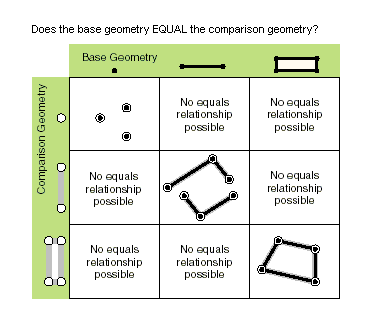 |
| generalize (max_offset) | Creates a new simplified geometry using a specified maximum offset tolerance. |
| getArea ({type}, {units}) | Returns the area of the feature using a measurement type. |
| getLength ({measurement_type}, {units}) | Returns the length of the feature using a measurement type. |
| getPart ({index}) | Returns an array of point objects for a particular part of geometry or an array containing a number of arrays, one for each part. |
| intersect (other, dimension) | Constructs a geometry that is the geometric intersection of the two input geometries. Different dimension values can be used to create different shape types. The intersection of two geometries of the same shape type is a geometry containing only the regions of overlap between the original geometries. 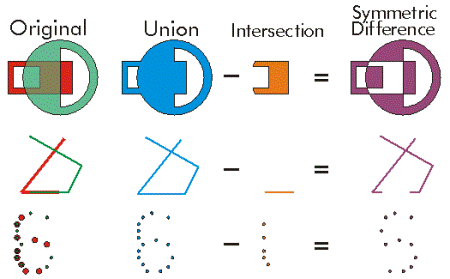 For faster results, test if the two geometries are disjointbefore calling intersect. |
| measureOnLine (in_point, {use_percentage}) | Returns a measure from the start point of this line to the in_point. |
| overlaps (second_geometry) | Indicates if the intersection of the two geometries has the same shape type as one of the input geometries and is not equivalent to either of the input geometries. Only True relationships are shown in this illustration. 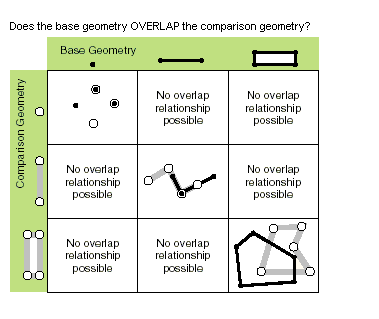 |
| pointFromAngleAndDistance (angle, distance, {method}) | Returns a point at a given angle and distance in degrees and meters using the specified measurement type. |
| positionAlongLine (value, {use_percentage}) | Returns a point on a line at a specified distance from the beginning of the line. |
| projectAs (spatial_reference, {transformation_name}) | Projects a geometry and optionally applies a geotransformation. To project, the geometry needs to have a spatial reference, and not have an UnknownCoordinateSystem. The new spatial reference system passed to the method defines the output coordinate system. If either spatial reference is unknown the coordinates will not be changed. The Z- and measure values are not changed by the ProjectAs method. |
| queryPointAndDistance (in_point, {as_percentage}) | Finds the point on the polyline nearest to the in_point and the distance between those points. Also returns information about the side of the line the in_point is on as well as the distance along the line where the nearest point occurs. |
| segmentAlongLine (start_measure, end_measure, {use_percentage}) | Returns a Polyline between start and end measures. Similar to Polyline.positionAlongLine but will return a polyline segment between two points on the polyline instead of a single point. |
| snapToLine (in_point) | Returns a new point based on in_point snapped to this geometry. |
| symmetricDifference (other) | Constructs the geometry that is the union of two geometries minus the instersection of those geometries. The two input geometries must be the same shape type.  |
| touches (second_geometry) | Indicates if the boundaries of the geometries intersect. Two geometries touch when the intersection of the geometries is not empty, but the intersection of their interiors is empty. For example, a point touches a polyline only if the point is coincident with one of the polyline end points. Only True relationships are shown in this illustration. 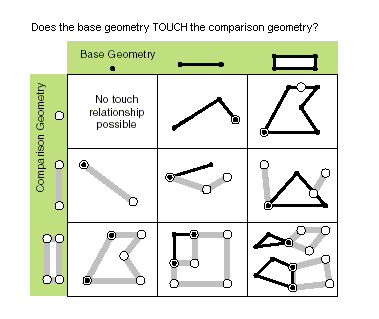 |
| union (other) | Constructs the geometry that is the set-theoretic union of the input geometries. The two geometries being unioned must be the same shape type.  |
| within (second_geometry, {relation}) | Indicates if the base geometry is within the comparison geometry. within is the opposite operator of contains. Only True relationships are shown in this illustration.  The base geometry is within the comparison geometry if the base geometry is the intersection of the geometries and the intersection of their interiors is not empty. within is a Clementini operator, except in the case of an empty base geometry. |
Métodos
angleAndDistanceTo (other, {method})| Parámetro | Explicación | Tipo de datos |
other | The second geometry. | PointGeometry |
method | PLANAR measurements reflect the projection of geographic data onto the 2D surface (in other words, they will not take into account the curvature of the earth). GEODESIC, GREAT_ELLIPTIC, LOXODROME, and PRESERVE_SHAPE measurement types may be chosen as an alternative, if desired.
(El valor predeterminado es GEODESIC) | String |
Valor de retorno
| Tipo de datos | Explicación |
| tuple | Returns a tuple of angle (in degrees) and distance (in meters) to another point. |
boundary ()
Valor de retorno
| Tipo de datos | Explicación |
| Object | A polygon's boundary is a polyline. A polyline's boundary is a multipoint, corresponding to the endpoints of the line. A point or multipoint's boundary is an empty point or multipoint. |
buffer (distance)
| Parámetro | Explicación | Tipo de datos |
distance | The buffer distance. The buffer distance is in the same units as the geometry that is being buffered. A negative distance can only be specified against a polygon geometry. | Double |
Valor de retorno
| Tipo de datos | Explicación |
| Polygon | The buffered polygon geometry. |
clip (envelope)
| Parámetro | Explicación | Tipo de datos |
envelope | An extent object used to define the clip extent. | Extent |
Valor de retorno
| Tipo de datos | Explicación |
| Object | An output geometry clipped to the specified extent. |
contains (second_geometry, {relation})| Parámetro | Explicación | Tipo de datos |
second_geometry | A second geometry. | Object |
relation | The spatial relationship type.
(El valor predeterminado es None) | String |
Valor de retorno
| Tipo de datos | Explicación |
| Boolean |
A return Boolean value of True indicates this geometry contains the second geometry. |
convexHull ()
Valor de retorno
| Tipo de datos | Explicación |
| Object | The resulting geometry. The convex hull of a single point is the point itself. |
crosses (second_geometry)
| Parámetro | Explicación | Tipo de datos |
second_geometry | A second geometry. | Object |
Valor de retorno
| Tipo de datos | Explicación |
| Boolean | A return Boolean value of True indicates the two geometries intersect in a geometry of a lesser shape type. |
cut (cutter)
| Parámetro | Explicación | Tipo de datos |
cutter | The cutting polyline geometry. | PolyLine |
Valor de retorno
| Tipo de datos | Explicación |
| Geometry | A list of two geometries. |
densify (type, distance, deviation)
| Parámetro | Explicación | Tipo de datos |
type | The type of densification, DISTANCE, ANGLE, or GEODESIC.
| String |
distance | The maximum distance between vertices. The actual distance between vertices will usually be less than the maximum distance as new vertices will be evenly distributed along the original segment. If using a type of DISTANCE or ANGLE, the distance is measured in the units of the geometry's spatial reference. If using a type of GEODESIC, the distance is measured in meters. | Double |
deviation | Densify uses straight lines to approximate curves. You use deviation to control the accuracy of this approximation. The deviation is the maximum distance between the new segment and the original curve. The smaller its value, the more segments will be required to approximate the curve. If using a type of DISTANCE, the deviation is measured in the units of the geometry's spatial reference. If using a type of ANGLE, the deviation is measured in radians. If using a type of GEODESIC, the deviation is not used. | Double |
Valor de retorno
| Tipo de datos | Explicación |
| Geometry | The densified geometry. |
difference (other)
| Parámetro | Explicación | Tipo de datos |
other | A second geometry. | Object |
Valor de retorno
| Tipo de datos | Explicación |
| Object | The resulting geometry. |
disjoint (second_geometry)
| Parámetro | Explicación | Tipo de datos |
second_geometry | A second geometry. | Object |
Valor de retorno
| Tipo de datos | Explicación |
| Boolean | A return Boolean value of True indicates that the two geometries share no points in common. |
distanceTo (other)
| Parámetro | Explicación | Tipo de datos |
other | A second geometry. | Object |
Valor de retorno
| Tipo de datos | Explicación |
| Double | The distance between the two geometries. |
equals (second_geometry)
| Parámetro | Explicación | Tipo de datos |
second_geometry | A second geometry. | Object |
Valor de retorno
| Tipo de datos | Explicación |
| Boolean |
A return Boolean value of True indicates that the two geometries are of the same shape type and define the same set of points in the plane. |
generalize (max_offset)
| Parámetro | Explicación | Tipo de datos |
max_offset | The maximum offset tolerance. | Double |
Valor de retorno
| Tipo de datos | Explicación |
| Geometry | The generalized geometry. |
getArea ({type}, {units})| Parámetro | Explicación | Tipo de datos |
type | PLANAR measurements reflect the projection of geographic data onto the 2D surface (in other words, they will not take into account the curvature of the earth). GEODESIC, GREAT_ELLIPTIC, LOXODROME, and PRESERVE_SHAPE measurement types may be chosen as an alternative, if desired.
(El valor predeterminado es GEODESIC) | String |
units | The units in which the area will be calculated. Areal unit of measure keywords: ACRES | ARES | HECTARES | SQUARECENTIMETERS | SQUAREDECIMETERS | SQUAREINCHES | SQUAREFEET | SQUAREKILOMETERS | SQUAREMETERS | SQUAREMILES | SQUAREMILLIMETERS | SQUAREYARDS | String |
Valor de retorno
| Tipo de datos | Explicación |
| Double | The area of the feature. By default, for Projected coordinate systems, area will be returned in the units of the coordinate system, and for Geographic coordinate systems, area will be returned in square meters. |
getLength ({measurement_type}, {units})| Parámetro | Explicación | Tipo de datos |
measurement_type | PLANAR measurements reflect the projection of geographic data onto the 2D surface (in other words, they will not take into account the curvature of the earth). GEODESIC, GREAT_ELLIPTIC, LOXODROME, and PRESERVE_SHAPE measurement types may be chosen as an alternative, if desired.
(El valor predeterminado es GEODESIC) | String |
units | The units in which the length will be calculated. Linear unit of measure keywords: CENTIMETERS | DECIMETERS | FEET | INCHES | KILOMETERS | METERS | MILES | MILLIMETERS | NAUTICALMILES | YARDS | String |
Valor de retorno
| Tipo de datos | Explicación |
| Double | The length of the feature. By default, for Projected coordinate systems, length will be returned in the units of the coordinate system, and for Geographic coordinate systems, length will be returned in square meters. |
getPart ({index})| Parámetro | Explicación | Tipo de datos |
index | The index position of the geometry. | Integer |
Valor de retorno
| Tipo de datos | Explicación |
| Array | getPart returns an array of point objects for a particular part of the geometry if an index is specified. If an index is not specified, an array containing an array of point objects for each geometry part is returned. |
intersect (other, dimension)
| Parámetro | Explicación | Tipo de datos |
other | The second geometry. | Object |
dimension | The topological dimension (shape type) of the resulting geometry.
| Integer |
Valor de retorno
| Tipo de datos | Explicación |
| Object | A new geometry (point, multipoint, polyline, or polygon) that is the geometric intersection of the two input geometries. |
measureOnLine (in_point, {use_percentage})| Parámetro | Explicación | Tipo de datos |
in_point | A point (PointGeometry or Point) that is used to measure from the start point of the polyline. | PointGeometry |
use_percentage | If False, the measure will be returned as a distance; if True, the measure will be returned as a percentage. (El valor predeterminado es False) | Boolean |
Valor de retorno
| Tipo de datos | Explicación |
| Double | A distance or percentage. |
overlaps (second_geometry)
| Parámetro | Explicación | Tipo de datos |
second_geometry | A second geometry. | Object |
Valor de retorno
| Tipo de datos | Explicación |
| Boolean | A return Boolean value of True indicates the intersection of the two geometries has the same dimension as one of the input geometries. |
pointFromAngleAndDistance (angle, distance, {method})| Parámetro | Explicación | Tipo de datos |
angle | The angle in degrees to the returned point. | Double |
distance | The distance in meters to the returned point. | Double |
method | PLANAR measurements reflect the projection of geographic data onto the 2D surface (in other words, they will not take into account the curvature of the earth). GEODESIC, GREAT_ELLIPTIC, LOXODROME, and PRESERVE_SHAPE measurement types may be chosen as an alternative, if desired.
(El valor predeterminado es GEODESIC) | String |
Valor de retorno
| Tipo de datos | Explicación |
| PointGeometry | Returns a point at a given angle and distance in degrees and meters. |
positionAlongLine (value, {use_percentage})| Parámetro | Explicación | Tipo de datos |
value | The distance along the line. If the distance is less than zero, then the starting point of the line will be returned; if the distance is greater than the length of the line, then the end point of the line will be returned. | Double |
use_percentage | The distance may be specified as a fixed unit of measure or a ratio of the length of the line. If True, value is used as a percentage; if False, value is used as a distance. For percentages, the value should be expressed as a double from 0.0 (0%) to 1.0 (100%). (El valor predeterminado es False) | Boolean |
Valor de retorno
| Tipo de datos | Explicación |
| PointGeometry | The point on the line at a specified distance from the beginning of the line. |
projectAs (spatial_reference, {transformation_name})| Parámetro | Explicación | Tipo de datos |
spatial_reference | The new spatial reference. This can be a SpatialReference object or the coordinate system name. | SpatialReference |
transformation_name | The geotransformation name. | String |
Valor de retorno
| Tipo de datos | Explicación |
| Object | The projected geometry. |
queryPointAndDistance (in_point, {as_percentage})| Parámetro | Explicación | Tipo de datos |
in_point | The input point (PointGeometry or Point). | PointGeometry |
as_percentage | If False, the measure will be returned as a distance; if True, the measure will be returned as a percentage. (El valor predeterminado es False) | Boolean |
Valor de retorno
| Tipo de datos | Explicación |
| tuple | Returns a tuple that includes the following:
|
segmentAlongLine (start_measure, end_measure, {use_percentage})| Parámetro | Explicación | Tipo de datos |
start_measure | The starting distance from the beginning of the line. | Double |
end_measure | The ending distance from the beginning of the line. | Double |
use_percentage | The start and end measures may be specified as fixed units or as a ratio. If True, start_measure and end_measure are used as a percentage; if False, start_measure and end_measure are used as a distance. For percentages, the measures should be expressed as a double from 0.0 (0 percent) to 1.0 (100 percent). (El valor predeterminado es False) | Boolean |
Valor de retorno
| Tipo de datos | Explicación |
| PolyLine | The segment of the line between two points. |
snapToLine (in_point)
| Parámetro | Explicación | Tipo de datos |
in_point | A point (PointGeometry or Point) to be snapped to the line. | PointGeometry |
Valor de retorno
| Tipo de datos | Explicación |
| PointGeometry | The snapped point. |
symmetricDifference (other)
| Parámetro | Explicación | Tipo de datos |
other | A second geometry. | Object |
Valor de retorno
| Tipo de datos | Explicación |
| Object | The resulting geometry. |
touches (second_geometry)
| Parámetro | Explicación | Tipo de datos |
second_geometry | A second geometry. | Object |
Valor de retorno
| Tipo de datos | Explicación |
| Boolean | A return Boolean value of True indicates the boundaries of the geometries intersect. |
union (other)
| Parámetro | Explicación | Tipo de datos |
other | A second geometry. | Object |
Valor de retorno
| Tipo de datos | Explicación |
| Object | The resulting geometry. |
within (second_geometry, {relation})| Parámetro | Explicación | Tipo de datos |
second_geometry | A second geometry. | Object |
relation | The spatial relationship type.
(El valor predeterminado es None) | String |
Valor de retorno
| Tipo de datos | Explicación |
| Boolean | A return Boolean value of True indicates this geometry is contained within the second geometry. |
Muestra de código
PointGeometry example
Create a point feature class from scratch.
import arcpy
# A list of coordinate pairs
#
pointList = [[1,2],[3,5],[7,3]]
# Create an empty Point object
#
point = arcpy.Point()
# A list to hold the PointGeometry objects
#
pointGeometryList = []
# For each coordinate pair, populate the Point object and create
# a new PointGeometry
for pt in pointList:
point.X = pt[0]
point.Y = pt[1]
pointGeometry = arcpy.PointGeometry(point)
pointGeometryList.append(pointGeometry)
# Create a copy of the PointGeometry objects, by using pointGeometryList
# as input to the CopyFeatures tool.
#
arcpy.CopyFeatures_management(pointGeometryList, "c:/geometry/a.gdb/points")